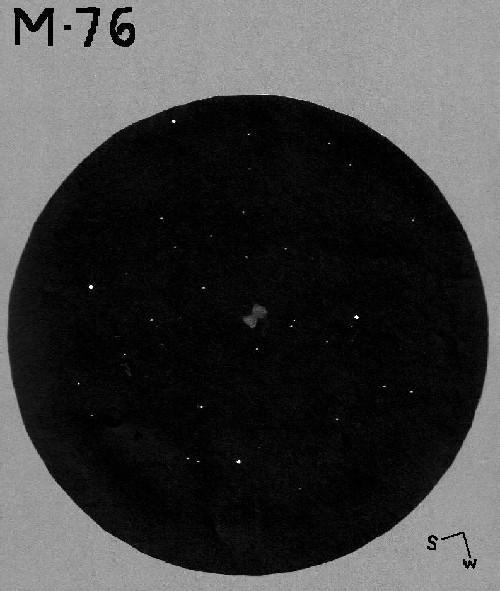
Planetary Nebula, M76
Sketch and Details by Frank McCabe
From my usual backyard observing location in south suburban , the sky glow prevents one from seeing any hints of the Milky Way or even M-31 (the Andromeda galaxy) at culmination without optical aid. Planetary nebula M-76 looks small (2’x1’) and concentrated enough that it is a fairly easy object to locate visually. It responds well to O III and narrow band light pollution filters because like other planetary nebulae it emits radiation at 496 and 501 nanometer wavelengths due to +2 oxygen ions. The 16.6 magnitude central star is too faint to be seen from my location. This nebula is commonly called the little dumbbell or barbell nebula because of its appearance. William Herschel catalogued the two bright end parts under separate numbers. There is a NE-SW orientation to the brightest end parts. No hint of the outer arcs projecting from the corners was visible even with filters and high powered eyepieces. This planetary nebula is located in the constellation of Perseus at R.A. 1hr. 42.4min., Dec. 51°34’. We are looking at this nebula from the side on view. If the 3000-5000 l.y. distance is correct, then M-76 is more than 1.0 l.y. in diameter.
No matter where you are in the northern hemisphere, try hunting for this object with a 4.25 inch (108mm) telescope or larger, you my be surprised at the view.
Sketching:
9”x11” white sketching paper; 2H, HB graphite pencils, black ink pen and a blending stump;
Scanned and inverted; brightness of some stars adjusted with MS Paint.
Scope: 10” f/5.7 Dobsonian: 24 mm wide field eyepiece 60x and 12 mm eyepiece 121x
Date and Time: 11-1-2008, 5:15 – 6:10 UT
Seeing: 6/10
Transparency: Average 3/5
Clear, 90% humidity
Temperature 10°C
NELM: 4.2
